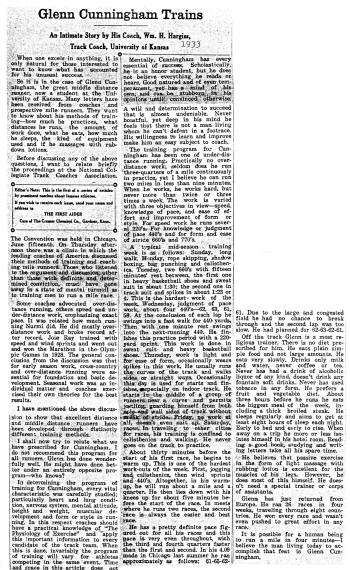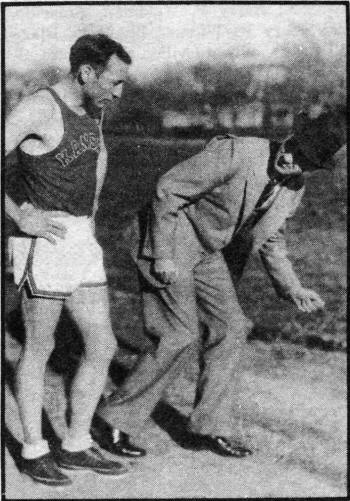|
|
Glenn Cunningham Trains
An Intimate Story by His Coach, Wm. H. Hargiss,
Track Coach, University of Kansas 1933
When
one excels in anything, it is only natural for those interested to want to know
what has accounted for his unusual success.
So it is in the case of Glenn Cunningham, the great middle
distance runner, now a student at the University of Kansas. Many letters have been
received from coaches and prospective mile runners. They want to know about his
methods of training--how
much he practices, what distances he runs, the amount of work done, what he eats,
how much he sleeps, the kind of equipment used and if he massages with rubdown lotions.
Before discussing, any of the above questions, I want to
relate briefly the proceedings at the National Collegiate Track Coaches Association.
The Convention was held in Chicago, June fifteenth. On Thursday afternoon there
was a clinic in which the leading coaches of America discussed their methods of
training and coaching mile runners. Those who listened to the argument and discussion,
other than those with definite: and determined conviction, must have gone away in
a state of mental turmoil as to training men to run a mile race.
Some coaches advocated over-distance running, others speed
and under-distance work, emphasizing exact pace. It was related how much running
Nurmi did. He did mostly over-distance work and broke record after record. Joie
Ray trained with speed and wind sprints and went out! and won the Marathon in the
Olympic Games in 1928. The general conclusion from the discussion was that for early
season work, cross-country and over-distance running were essential for foundation
and basic development. Seasonal work was an individual matter and coaches exercised
their own theories for the best results.
I have mentioned the above discussion to show that excellent
distance and middle distance runners have been developed through distinctly different
training methods.
I shall now try to relate what we have prescribed for Cunningham.
I do not recommend this program for all runners. Glenn, has done wonderfully well.
He might have done better under an entirely opposite program--who knows?
In determining the program of training for Cunningham,
every vital characteristic was carefully studied; particularly heart and lung condition,
nervous system, mental, attitude, height and weight, muscular development and form
or style in running. In this respect coaches should have a practical knowledge of
"The Physiology of Exercise" and apply this important information to every candidate
of the track team. When this is done, invariably the program of training will vary
for athletes competing in the same event. Time and space in this article does not
permit showing how conclusions may be reached through simple experiments.
Mentally, Cunningham has every essential of success. Scholastically,
he is an honor student, but he does not believe everything he rereads or hears.
Good natured and of even temperament yet has a mind of his own and can be stubborn
in his opinions until convinced otherwise.
A will and determination to succeed that is almost undeniable.
Never boastful, yet deep in his mind he feels that there is not a man living whom
he can't defeat in a footrace. His willingness to learn and improve make him an
easy subject to coach..
The training program for Cunningham has been one of under-distance
running. Practically no over-distance work; seldom does he run three-quarters of
a mile continuously in practice, yet I believe he can run two miles in less than
nine minutes. When he works, he works hard, but never more than twice or three times
a week. The work is varied with three objectives in view--speed, knowledge of pace,
and ease of effort and improvement of form or style. For speed work he runs several
220's For knowledge or judgment of pace 440's and for form and ease of stride 660's
and 770's.
A typical mid-season training week is as follows: Sunday,
long walk. Monday, rope skipping, shadow boxing, bag punching and calisthenics.
Tuesday, two 660's with fifteen minutes rest between, the first one in heavy basketball
shoes and sweat suit in about 1:30; the second one in track suit and spikes in about
1:23 or 4. This is the hardest work of the week. Wednesday, judgment of pace work,
about four 440's--62, 63, 61, 58. At the conclusion of each lap he swings into a
fast walk for 440 yards. Then, with one minute rest swings into the next-running
440. He finishes this practice period with a 220-yard sprint. This work is done
in sweat suit, and heavy basketball shoes. Thursday, work is light and for ease
of form, occasionally wears spikes for this work. He usually runs the curves of
the track and walks sides or straight ways. Occasionally this day is used for starts
and finishes, especially on indoor track. He starts in the middle of a group of
runners near a curve and permits jostling, guarding himself from both pole and wall
sides of track without
break in strides. Friday, no work at all, doesn't even suit up. Saturday, races.
In traveling to other cities for races, his training is confined to calisthenics
and walking. He never goes on the track to practice.
About thirty minutes before the start his first race, he
begins to warm up. This is one of the hardest work-outs of the week. First, jogging
and calisthenics, then wind sprints and 440's. Altogether, in his warm-up, he will
run about a mile and a quarter. He then lies down with his knees. up for about five
minutes be fore the start of the race. In meets where he runs two races, the second
race is always the easier and best race.
He has a pretty definite pace figured out for all his races
and this pace is very even throughout, with the third and fourth quarters faster
than the first and second. In his 4.09
made in Chicago last summer, he ran approximately as follows: 61-65-62-61. Due to
the large and congested field he had no chance to break through and the second lap
was too slow. He had planned for 62-63-62-61.
Off the track Glenn is a most religious trainer. There
is no diet prescribed for him. He eats plain simple food and not large amounts.
He eats very slowly. Drinks only milk and water, never coffee or tea. Never has
had a drink of alcoholic liquor of any kind, doesn't drink any fountain soft drinks.
Never has used tobacco in any form. He prefers a fruit and vegetable diet. About
three hours before he runs he eats the biggest meal of the week, including a thick
broiled steak. He sleeps regularly and aims to get at least eight hours of sleep
each night. Early to bed and early to rise. When away on a trip he more or less
isolates himself in his hotel room. Reading a good book, studying and writing letters
take all his spare time.
He believes that passive exercise in the form of light
massage with rubbing lotion is excellent for the muscles of his legs. However, he
does most of this himself. He doesn't need a special trainer or corps of assistants.
Glenn has just returned from Europe. He ran 26 races in
four weeks, traveling through eight countries. He won every race and wasn't even
pushed to great effort in any
It is possible for a human being to ran a mile in four minutes--I believe the man
living today to accomplish that feat is Glenn Cunningham.